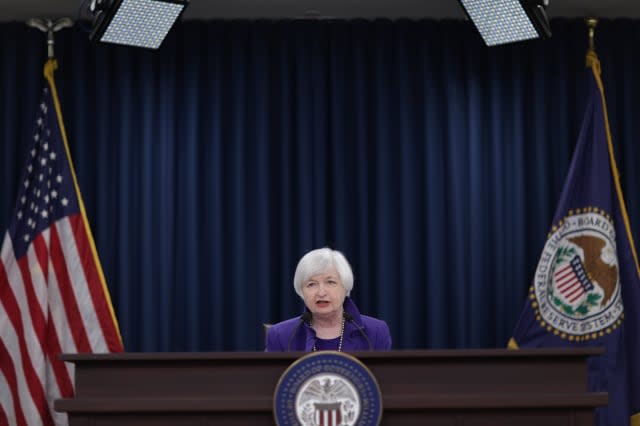Federal Reserve lifts interest rate as US economy shows encouraging signs

The Federal Reserve has increased US interest rates for the first time in nearly a decade, marking a milestone in the recovery of the world's biggest economy.
Interest rates in America have not been increased since June 2006 and have remained at a target range between zero and 0.25% since December 2008.
But this evening, the Federal Reserve raised its key interest rate by 0.25%, ending seven years of near-zero rates.
The move immediately led to calls in Britain for the Bank of England Monetary Policy Committee to follow suit.
The decision by the Federal Open Market Committee (FOMC) is a sign that the US economy is back on track after the financial crisis and ready to wean itself off the financial life support of record low rates.
There have been encouraging signs for the US economy in recent months, with unemployment falling to 5% from a peak of 10% in 2009 and inflation beginning to creep up, with figures showing a bigger-than-expected rise in prices of 0.5% in the year to November.
Stock markets have surged in the past two days ahead of the decision, which will end many months of uncertainty over US monetary policy.
Equities fell sharply in September after the Fed made the surprise decision to keep rates on hold, confounding expectations for a rise.
But the decision to hike the cost of borrowing in the US comes at a time when the global economy and China's growth have been slowing.
There are concerns that a rise will compound the slowdown, as higher rates in America would lead to a stronger dollar and this in turn would put pressure on emerging markets, where many companies borrow in dollars.
A hike would also see US and European monetary policy move in opposite directions.
The European Central Bank earlier this month announced a cut to overnight deposit rates from minus 0.2% to minus 0.3% and extended a 60 billion euro (£43 billion) stimulus programme by six months.
Meanwhile, the Bank of England this month voted to keep rates on hold at 0.5%, where they have been for more than six years, with many forecasting a rise will not come in the UK until well into 2016.
Bank of England Governor Mark Carney has been quick to stress that a rise in US rates does not mean UK borrowing costs will have to increase.
He told the Financial Times ahead of the Fed's decision that Britain still faced a "low for long" scenario, insisting the economic conditions for a rise in the UK were still not in place.
Minutes of the Bank's rates meeting this month confirmed this view, stating that the rate-setting committee believed there was ''no mechanical'' link between UK monetary policy and that of other central banks.
Attentions worldwide will now focus on the future path of US interest rates as the Fed looks to return borrowing costs to more normal levels.
The Fed is expected to raise rates gradually, with many economists expecting only three or four increases in 2016, while others believe policymakers may wait as late as June before raising them again.
Calls for the Bank of England to start raising rates in the UK swiftly followed the announcement.
James Sproule, chief economist at the Institute of Directors, said: "The Federal Reserve's decision to start normalising interest rates is a welcome sign of the central bank's confidence in the US economy.
"For Britain, higher US interest rates give the Bank of England the flexibility to start normalising rates on this side of the Atlantic as well. Since the Fed has acted first, it diminishes the possibility of an increase in UK interest rates upsetting the value of the pound against the dollar - just one more obstacle which could have worried the Bank.
"While inflation is clearly way off the Bank's 2% target, the Monetary Policy Committee must look past this temporary period of low inflation and act soon. Interest rates still need to be normalised, not to tame rising prices but to take away monetary stimulus which has done its job to spur growth, is no longer needed and could be leading to capital misallocation.
"There will always be a thousand possible excuses not to raise rates, but we must take account of the exceptional circumstances in which we find ourselves. We are probably close to peak employment in the UK, with employment growth set to plateau next year. All these factors should encourage rate-setters in the UK to think seriously about raising rates in early 2016."
Andrew Sentance, a former member of the Monetary Policy Committee, told Sky News that the Fed's move might bring the issue of interest rate rises in the UK "back into focus".
He said: "The markets are expecting this to be the first of a number of quite gradual rises in the States and my expectation would be that next year we will start to see interest rate rises here in the UK.
"If the US economy absorbs this interest rate rise, and perhaps one or two others, quite easily, that would give the Monetary Policy Committee here in the UK more confidence that we could do the same thing here.
"We mustn't wait until all the danger lights are flashing before we make these first rises in interest rates, because then we're going to have to raise interest rates quite rapidly, and that's really what the MPC wants to avoid."
If there was no rise in interest rates in the UK "quite soon", the pound may weaken further against the dollar, he said.


